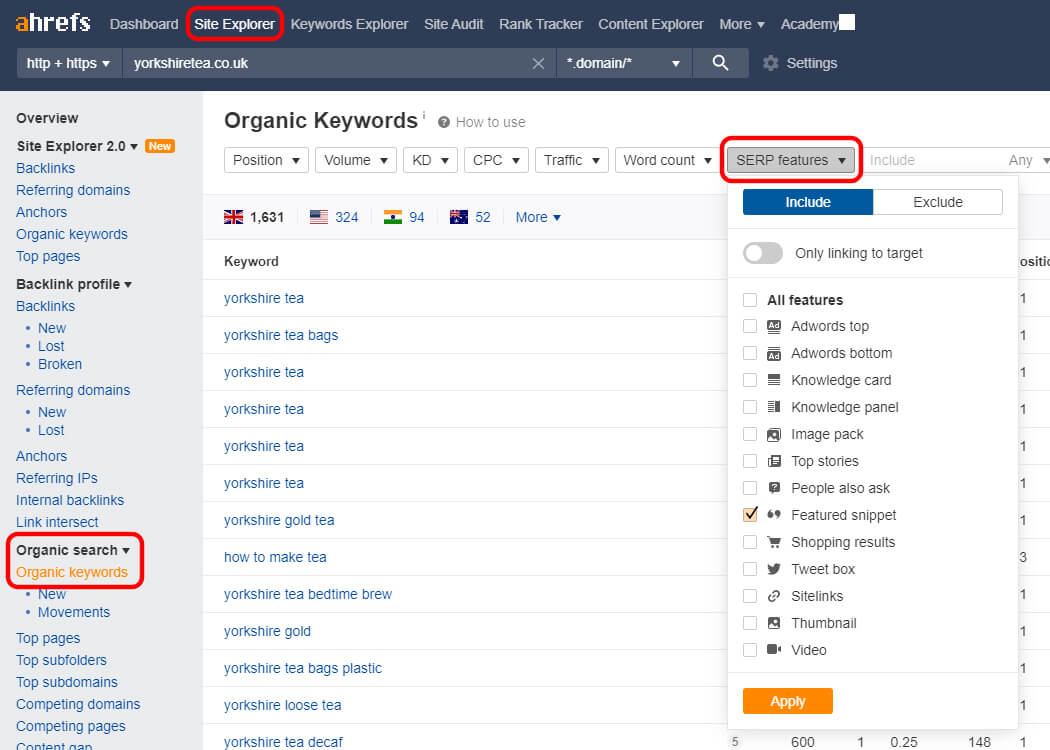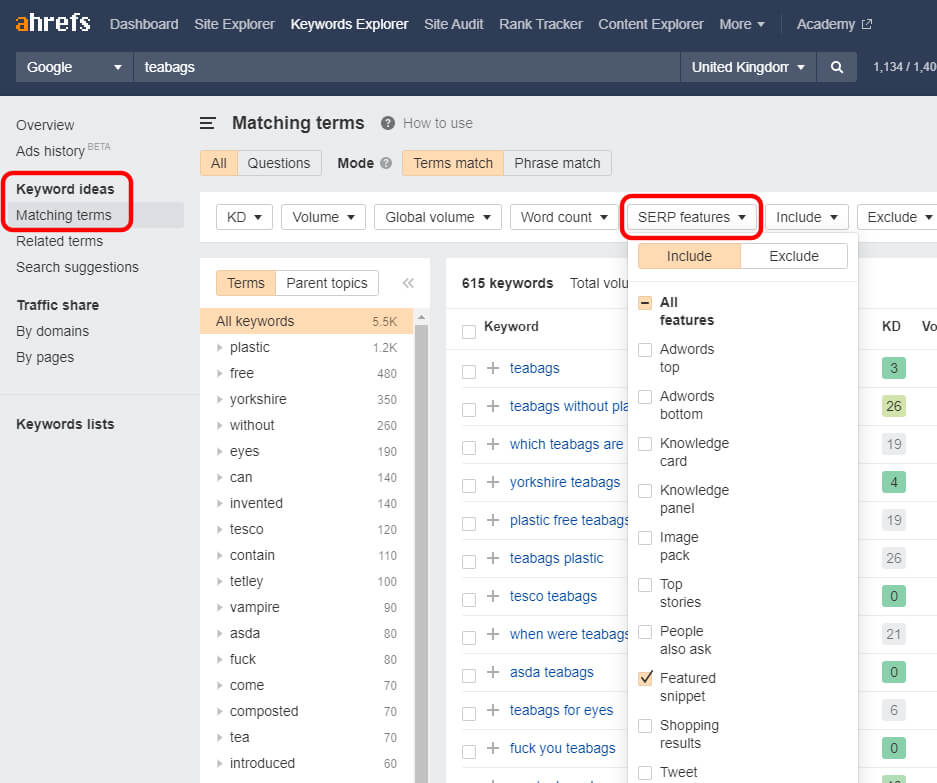Owning the top spot for each Search Engine Results Page (SERP) that is directly relevant to your brand. Broadly speaking, that’s the goal of virtually every business in the modern world when it comes to SEO, right?
Well, what if I told you that not all SERPs are built equally, and that the way you engineer your organic content to target specific types of SERPs determines whether or not you can own that treasured #1 spot.
You might say, ‘Tom, I’m an SEO nerd, show me how to get the snippet already’ – but if you aren’t familiar with featured snippets, here’s a quick run down of what they involve and why they matter.
What is a featured snippet?
A featured snippet, often referred to as ‘position 0’, is essentially a selected excerpt of content chosen by Google’s algorithms that is seen to directly match the searcher’s intent.
Let’s say you’ve identified a decline in sales during lockdown and want to ramp up activity to compensate for this with a deadline set for restrictions lifting. As with many problems these days, the first step to solving it may simply be to google ‘how to generate more leads’, which would the following result:

This is a featured snippet – confirmed by the little ‘about featured snippets’ button below each result. There’s a good chance that the text within a featured snippet is THE result you’ve been searching for- hence it being displayed above all others.
As you can see in the screenshot above, the featured snippets take up a good chunk of space in desktop results, and even more so on mobile devices- where you’ll find snippets covering around 50% of the screen. They’re difficult to miss, by design.
Types of featured snippet
Slick paragraphs aren’t always the most helpful way of answering a question. That’s why Google’s SERP Features includes four main types of snippet. These are:
- Paragraphs.
- Lists (bulleted or numbered).
- Tables.
- Video.
Within each snippet type, you’ll see content that really captures the essence of the searcher’s intent, whether they were Googling tax legislation or how best to recruit new team members.
There are also knowledge card or entity carousel snippet results, but these are typically difficult to optimise for and niche in use- so let’s focus on what you can action.
Why do snippets matter?
The cop-out answer here would be a generic ‘because visibility is important, and sitting atop the SERPs is the best way of boosting visibility’. More interestingly, though, featured snippets comprise around 19% of SERPs according to a recent study by Search Engine Journal. That’s a huge amount.
What’s more, 70% of featured snippets found in this study were text-based, meaning integrated text that’s optimised into your existing content writing could be an easy way of maximising the return on your efforts.
Conversely, neglecting featured snippet considerations and never really looking at what type of SERPs are generated for your target keywords could result in missed opportunities.
The risk of excessive snippet visibility
For full disclosure, snippets aren’t always the best friend of a content marketer. Think about it, if you’re appearing #1 in search results for quick questions with your precise information, users may absorb that information, then get back on with their day- exiting search results.
That ultimately means that your content could drive less clicks, but that isn’t necessarily a bad thing. A 2017 study by Ahrefs looked at what percentage share of clicks is driven by different positions on the SERP. It found that featured snippets (position 1) drive only 8.6% of clicks, while the next highest ranked page sees roughly 19.6% of clicks.
This sounds like a doom and gloom stat for featured snippets, however it’s important to also understand that zero-click searches have gradually increased over the years – and around 50% of searches today yield no clicks.
So, there’s more to the story than click data alone. Instead of a tunnel-vision approach on CTRs, it’s probably best to build a broader picture of how visible your brand is, and lean more heavily on rankings as a performance metric. Besides, SERP features can fluctuate as algorithms evolve and update, which we simply can’t control.
How to find and capture a snippet
Let’s focus, then, on what we can control.
- We can identify which SERPs return snippets.
- We can optimise our content to pinch those snippets.
Here’s exactly how.
Navigate to the ‘Site Explorer’ tool within Ahrefs. Input your target domain, I’ve used Yorkshire Tea as an example considering that we’re based in Yorkshire, and that you’ll have earned one shortly.

From there, navigate to ‘Organic keywords’ via the left menu. Now that you’re looking at a list of organic keywords your brand ranks for, you can filter these further using various options within ‘SERP features’.
Once these filters are applied, you’ll see a list of keywords your brand currently ranks for that actually return featured snippet SERPs. If you’re ranking in position 1, then congratulations- you own that snippet!

If not, however, then there’s a clear opportunity to optimise for queries for which you’re ranking in positions two or lower. Yorkshire tea here could improve their /how-to-make-a-proper-brew/ URL to better answer searches for ‘how to make tea’.
This individual URL could potentially capture featured snippets within two SERPs that ask the exact same question in slightly different ways.
We’ve identified that owning the snippet may not result in more clicks, but there’s an unquantifiable value to being presented as the source of knowledge when a user searches for ‘how to make tea’, and quotes Yorkshire Tea as the source when telling their friends what the ‘right way’ is.
Clever ways of using featured snippets
We’ve covered why feature snippets matter and the value they can bring to your business, but let’s take a look at some practical ways in which you can actually optimise for them.
- Optimising existing content
In line with the approach we outlined earlier in the piece, you can look for featured snippets that are relevant to your existing content, then optimise for these snippets as best you can.
- Find featured snippet opportunities within new content
If you’re doing your keyword research within ahrefs’ Keywords Explorer tool, you’ll find a similar ‘SERP Features’ button that allows you to indicate which keywords return snippet SERPs – irrespective of whether or not you rank for them.

This more proactive approach to snippets could enable you to factor snippets into your content planning, meaning you can design your content to target them, rather than producing a bunch of content and retrospectiveley optimising it.
- Researching competitor snippets
It could also be worth looking at how competitors optimise for snippets as part of their content strategy. You might identify that actually snippets form a huge part of competitor targeting, which may give you insights and inspiration as to how you could shape your own strategy.
You can review competitor snippets exactly as you view your own within ahrefs’ Site Explorer tool – so if you have the time to dedicate to research, look at the most effective optimisation tactics competitors are using to acquire snippets and factor them into your own business’ workflow.
Our approach to featured snippets
So, featured snippets are all about improving visibility, serving users your expertise succinctly, and being presented in a special position above the rest of organic search results at the potential expense of a few clicks.
The real question is: ‘how do you fit featured snippet optimisations into a wider content strategy?’
It requires a complex answer, but one piece of food for thought is that there’s a trend within content whereby long-form, substantive guide articles are reportedly performing incredibly well. Assuming this content format is at the heart of your approach, you could look to optimise normally around your core terms, while also targetting specific featured snippets within h2 and h3 sections; increasing the amount of keywords your article ranks for.
It’s commonly accepted that acquiring strong rankings is in of itself a good indicator to Google that your content is authoritative/trustworthy, and so picking up featured snippets where possible is rarely a bad idea.
If you’re interested in learning how to maximise the use of SERP features for your site, reach out to us for a quote on the impact a cleverly crafted content strategy could have on your traffic.





